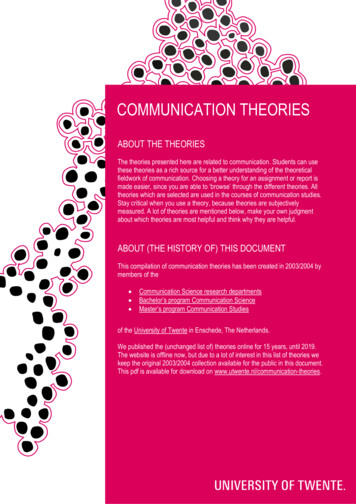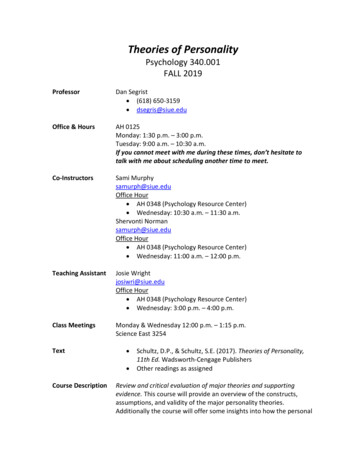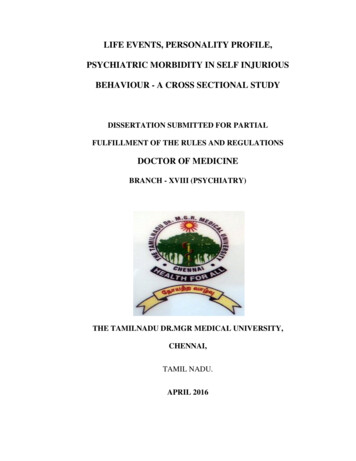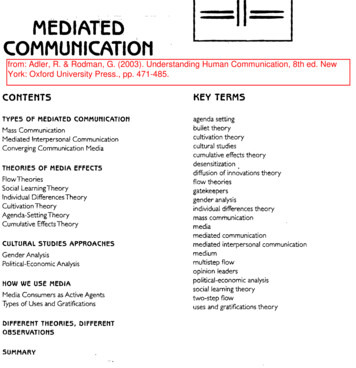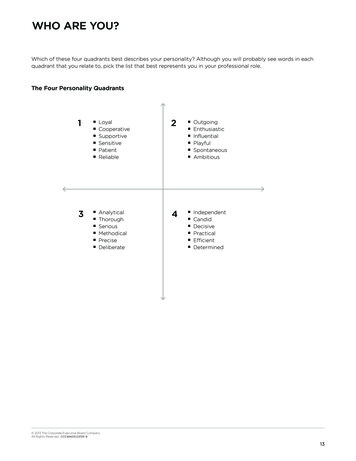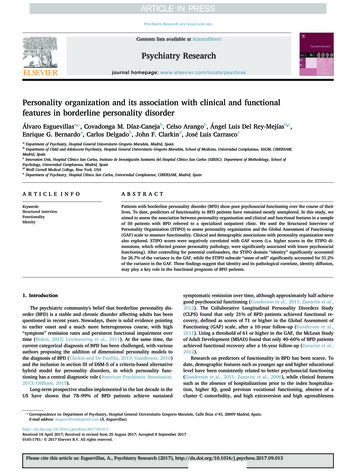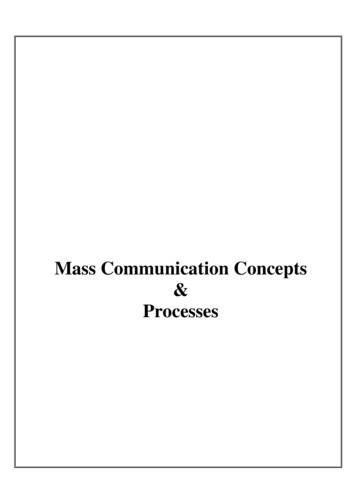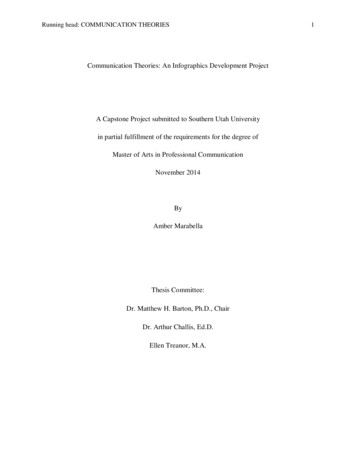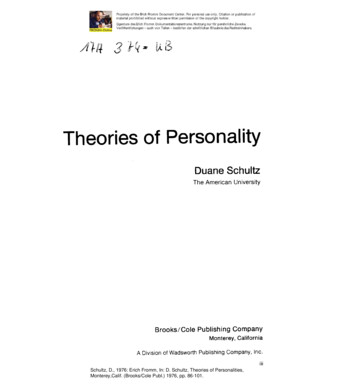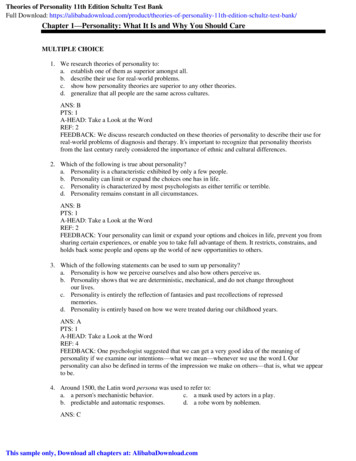
Transcription
Theories of Personality 11th Edition Schultz Test BankFull Download: rsonality-11th-edition-schultz-test-bank/Chapter 1—Personality: What It Is and Why You Should CareMULTIPLE CHOICE1. We research theories of personality to:a. establish one of them as superior amongst all.b. describe their use for real-world problems.c. show how personality theories are superior to any other theories.d. generalize that all people are the same across cultures.ANS: BPTS: 1A-HEAD: Take a Look at the WordREF: 2FEEDBACK: We discuss research conducted on these theories of personality to describe their use forreal-world problems of diagnosis and therapy. It's important to recognize that personality theoristsfrom the last century rarely considered the importance of ethnic and cultural differences.2. Which of the following is true about personality?a. Personality is a characteristic exhibited by only a few people.b. Personality can limit or expand the choices one has in life.c. Personality is characterized by most psychologists as either terrific or terrible.d. Personality remains constant in all circumstances.ANS: BPTS: 1A-HEAD: Take a Look at the WordREF: 2FEEDBACK: Your personality can limit or expand your options and choices in life, prevent you fromsharing certain experiences, or enable you to take full advantage of them. It restricts, constrains, andholds back some people and opens up the world of new opportunities to others.3. Which of the following statements can be used to sum up personality?a. Personality is how we perceive ourselves and also how others perceive us.b. Personality shows that we are deterministic, mechanical, and do not change throughoutour lives.c. Personality is entirely the reflection of fantasies and past recollections of repressedmemories.d. Personality is entirely based on how we were treated during our childhood years.ANS: APTS: 1A-HEAD: Take a Look at the WordREF: 4FEEDBACK: One psychologist suggested that we can get a very good idea of the meaning ofpersonality if we examine our intentions—what we mean—whenever we use the word I. Ourpersonality can also be defined in terms of the impression we make on others—that is, what we appearto be.4. Around 1500, the Latin word persona was used to refer to:a. a person's mechanistic behavior.c. a mask used by actors in a play.b. predictable and automatic responses.d. a robe worn by noblemen.ANS: CThis sample only, Download all chapters at: AlibabaDownload.com
PTS: 1A-HEAD: Take a Look at the WordREF: 4FEEDBACK: The word personality goes back to about the year 1500 and derives from the Latin wordpersona, which refers to a mask used by actors in a play. It's easy to see how persona came to refer toour outward appearance, the public face we display to the people around us.5. Identify a true statement about an individual's personality.a. It can be stable and predictable.c. It is based on personal traits and behavior.b. It is generally resistant to sudden changes. d. All of these are correct.ANS: DPTS: 1A-HEAD: Take a Look at the WordREF: 5FEEDBACK: We assume that personality is relatively stable and predictable. Sometimes ourpersonality can vary with the situation. Yet although it is not rigid, it is generally resistant to suddenchanges.6. The personality of an individual is .a. completely based on self-perceptionb. unstable and unpredictablec. a unique cluster of characteristicsd. determined at birth and stays unchangedANS: CPTS: 1A-HEAD: Take a Look at the WordREF: 6FEEDBACK: Personality is an enduring and unique cluster of characteristics that may change inresponse to different situations. We see similarities among people, yet we sense that each of uspossesses special properties that distinguish us from all others.7. Which of the following is true of people using social networking sites, such as Facebook?a. They tend to portray an idealized self-image of themselves.b. They feel they are able to express their true selves.c. They have a tendency to present themselves as much more emotionally stable.d. All of these are correct.ANS: DPTS: 1A-HEAD: Personality and the Social MediaREF: 6FEEDBACK: Increasingly, many of us display another face, not in person, but through the Internet onsocial networking Web sites such as Facebook. Some research suggests that most people are honestabout their online faces. A recent large-scale study in Germany found that many people have atendency to present themselves online as being much more emotionally stable than they really are(Blumer & Doring, 2012).8. Research that was conducted in diverse countries, such as the Netherlands, Serbia, Hong Kong, andKorea, suggests that those who have a high level of social network use are than those who use itless.a. more introvertedb. less irritablec. less anxiousd. more emotionally stable
ANS: APTS: 1A-HEAD: Personality and the Social MediaREF: 7FEEDBACK: Psychologists have found that the use of online social networking sites like Facebookcan both shape and reflect our personalities. Studies conducted in such diverse countries as theNetherlands, Serbia, Hong Kong, and Korea have demonstrated that those who reported excessive useof social media tend to be more lonely, introverted, and low in self-esteem than those who use it less.9. Which of the following is true of the personality differences among cell phone users as discovered byresearch?a. Those who were less conscientious spent more time texting than those who were moreconscientious.b. Individuals with a weak sense of self-identity spent much more time making calls thanindividuals who scored higher on that personality characteristic.c. Those who were shy spent less time texting when compared to those who wereextraverted.d. Introverts spent much more time changing their ring tones and wallpapers than extraverts.ANS: APTS: 1A-HEAD: Personality and the Social MediaREF: 8FEEDBACK: Studies found that those who were more neurotic and less conscientious and shy spentmore time texting on their phones than those who were less neurotic and more conscientious. Researchinvolving teenagers and adults in Australia found that extraverts and those with a strong sense ofself-identity spent much more time making calls and changing their ring tones and wallpaper thanthose scoring lower on these personality characteristics.10. In the past, were more likely to be used in research on personality theory.a. White womenc. White menb. Latino mend. Black menANS: CPTS: 1A-HEAD: The Role of Race and Gender in Shaping PersonalityREF: 8FEEDBACK: In the field of personality theory, virtually all the patients and subjects the earliertheories were based on were White. Also, the majority of the patients and subjects were men. Yet, thepersonality theorists confidently offered theories that were supposed to be valid for all people,regardless of gender, race, or ethnic origin.11. Which of the following is true of the assumptions made by early personality theorists?a. Personality theories were valid for all people, regardless of gender and race.b. Siblings growing up together had highly identical personality types.c. Social and environmental forces do not have any effect on shaping personality.d. A person's ethnic background largely influences his or her personality.ANS: APTS: 1A-HEAD: The Role of Race and Gender in Shaping PersonalityREF: 8FEEDBACK: The personality theorists confidently offered theories that were supposed to be valid forall people, regardless of gender, race, or ethnic origin. Although the theorists accepted, to some degree,the importance of social and environmental forces in shaping personality, they tended to ignore or
minimize the influence of gender and ethnic background.12. Girls and boys are usually reared according to:a. the norms of the neighborhood where they were raised.b. the explicit wishes of the grandparents.c. books on parenting.d. traditional stereotypes.ANS: DPTS: 1A-HEAD: The Role of Race and Gender in Shaping PersonalityREF: 9FEEDBACK: We know that boys and girls are usually reared according to traditional genderstereotypes, and this upbringing also influences personality in different ways. Research hasdocumented many differences between men and women on specific personality factors.13. The research conducted by Barrett, Lane, Sechrest, and Schwartz (2000) suggests that:a. men are more concerned with what people think of them than women do.b. women exhibit greater emotional complexity than men.c. women are more resistant to emotional disorders than men.d. men are more likely to suffer from anxiety than women.ANS: BPTS: 1A-HEAD: The Role of Race and Gender in Shaping PersonalityREF: 9FEEDBACK: One large-scale study of the intensity of emotional awareness and expression comparedmale and female college undergraduates at two American universities and male and female students atmedical schools in the United States and in Germany. The results showed that women from bothcountries displayed greater emotional complexity and intensity than did men (Barrett, Lane, Sechrest,& Schwartz, 2000).14. Which of the following statements is true of research on the effect of culture in shaping personality?a. European Americans displayed a far greater number of negative emotions than did theAsian Americans.b. Recent Chinese immigrants to Canada scored significantly higher in extraversion thanthose who have been living for past ten or more years.c. Brain wave activity in response to a particular visual stimulus has been found to be thesame among people from all cultures.d. In general, people from Western cultures are more optimistic than people from Easterncultures.ANS: DPTS: 1A-HEAD: The Role of Culture in Shaping PersonalityREF: 9FEEDBACK: Western people in general, and Americans, in particular, also exhibit greater optimismand view themselves and their future more positively. They even consider their sports teams, cities,and friends to be superior, when compared to those of Asian cultures (Endo, Heine, & Lehman, 2000).15. The concept of karma:a. may be seen as a deterministic view of human nature by Buddhists.b. emphasizes free choice and action.c. encourages an active, rebellious personality type.d. has shaped the beliefs of many Islamic communities.
ANS: APTS: 1A-HEAD: The Role of Culture in Shaping PersonalityREF: 10FEEDBACK: The concept of karma has for centuries shaped the outlook of the people of India andother countries that accept Hinduism or Buddhism. It may be seen as a fatalistic and deterministic viewof human nature.16. A person from a collectivist society is more likely to focus on:a. group values.c. competitiveness.b. assertiveness.d. self-enhancement.ANS: APTS: 1A-HEAD: The Role of Culture in Shaping PersonalityREF: 10FEEDBACK: In an individualistic society, the focus is on personal freedom, choice, and action. In acollectivist society, the focus is on group norms and values, group role expectations, and other culturalconstraints on behavior.17. Identify a cultural difference between individualism and collectivism.a. The levels of anxiety and depression have been found to be higher in collectivistic culturesthan in the individualistic ones.b. Individualism has traditionally been encouraged in Asian cultures.c. Collectivism has traditionally been encouraged in Western cultures.d. The levels of anxiety and depression have been found to be lower in collectivistic culturesthan in individualistic ones.ANS: DPTS: 1A-HEAD: The Role of Culture in Shaping PersonalityREF: 10FEEDBACK: Individual competitiveness and assertiveness are often seen as undesirable and contraryto Asian cultural standards. Western cultures are typically depicted as the opposite. Genetic differencesbetween people in collectivistic versus individualistic cultures have been linked to lower levels ofanxiety and depression in collectivistic cultures and higher levels in individualistic cultures.18. A study on child-rearing practices in different cultures and their effects on personality concluded that:a. restrictive parental practices adversely affected the mental health and emotionalwell-being of Arab teenagers.b. the effect child-rearing practices have on the development of personality is neutralized bythe time an individual reaches adolescence.c. parents in individualistic cultures tended to be noncoercive, democratic, and permissive.d. Chinese mothers living in Canada were found to be less authoritarian in raising theirchildren than non-Chinese mothers in Canada.ANS: CPTS: 1A-HEAD: The Role of Culture in Shaping PersonalityREF: 11FEEDBACK: In the individualistic culture of the United States, parents tend to be noncoercive,democratic, and permissive in their child-rearing techniques. In collectivist cultures, such as Asian andArab societies, parental practices tend to be more authoritarian, restrictive, and controlling.
19. Which of the following is true of self-enhancement?a. It is prevalent among Nordic cultures.c. It is defined as the tendency to make oneconspicuous.b. It is defined as the process ofd. It is genetically induced and determined atadministering rewards or punishments tobirth.oneself.ANS: CPTS: 1A-HEAD: The Role of Culture in Shaping PersonalityREF: 11FEEDBACK: Self-enhancement is defined as the tendency to promote oneself aggressively and makeone conspicuous. The opposite of that, self-effacement, is considered to be more in agreement with thecultural values of Asian and Nordic societies.20. Which of the following is a problem limiting the applicability of cross-cultural personality research?a. Much less research has been conducted on c. The majority of the research onpersonality in English-speaking countriespersonality has been done on children andthan in Latin America.the aged in Latin America.b. Much of the personality research that has d. The majority of the research onbeen done in other languages have notpersonality conducted in thebeen made widely available inEnglish-speaking countries has not beenEnglish-language sources.well-documented until very recently.ANS: BPTS: 1A-HEAD: The Role of Culture in Shaping PersonalityREF: 12FEEDBACK: Much less research has been conducted on personality in African and South Americannations than in English-speaking countries, or in many of the countries of Europe and Asia. Also,much of the research that has been conducted among those populations has not been made widelyavailable in English-language sources.21. A limiting factor in the applicability of cross-cultural research of personality is that subjects:a. demand exorbitantly high amounts to participate in research studies.b. easily conform to how a researcher wants them to respond.c. are mostly American college students.d. are mostly children and adolescents in treatment.ANS: CPTS: 1A-HEAD: The Role of Culture in Shaping PersonalityREF: 12FEEDBACK: A problem limiting the applicability of cross-cultural personality research is that themajority of studies in personality use American college students as subjects. Much less research hasbeen conducted on personality in African and South American nations than in English-speakingcountries, or in many of the countries of Europe and Asia.22. Which of the following is true of the principle of reliability that is used in personality assessment?a. It involves the consistency of response to an assessment device.b. It is an indicator of the validity of an assessment technique.c. It is an assessment device measuring what it is expected to measure.d. It involves selecting the most accurate score from a group of results.ANS: A
PTS: 1A-HEAD: Assessing Your PersonalityREF: 13FEEDBACK: Reliability involves the consistency of response to an assessment device. It is commonto find some slight variation in scores when a test is taken a second time, but if the variation is large,then something is wrong with the test or with the method of scoring it.23. Which question best clarifies the meaning of validity?a. Has the test been taken by many people?b. Does the student know what is on the test?c. Does the test measure what it is intended to measure?d. Are the results of the test consistent?ANS: CPTS: 1A-HEAD: Assessing Your PersonalityREF: 13FEEDBACK: Validity refers to whether an assessment device measures what it is intended to measure.If a test does not measure what it claims to, then it is not valid and its results cannot be used to predictbehavior.24. Which of the following approaches to personality assessment involves asking people to give anaccount of and answer questions about their behavior and feelings in various situations?a. Behavioral assessment proceduresc. Experience sampling proceduresb. Projective techniquesd. Self-report personality testsANS: DPTS: 1A-HEAD: Assessing Your PersonalityREF: 14FEEDBACK: The self-report inventory or test approach involves asking people to report onthemselves by answering questions about their behavior and feelings in various situations. These testsinclude items dealing with symptoms, attitudes, interests, fears, and values.25. The most widely used self-report personality test is the:a. Rorschach Inkblot Technique.c. Myers-Briggs Type Indicator.b. Minnesota Multiphasic Personalityd. Thematic Apperception Test.Inventory.ANS: BPTS: 1A-HEAD: Assessing Your PersonalityREF: 14FEEDBACK: The Minnesota Multiphasic Personality Inventory (MMPI) has been translated into morethan 140 languages and is the world's most widely used psychological test. The MMPI is a true-falsetest that consists of 567 statements.26. In 1992, the Minnesota Multiphasic Personality Inventory-A (MMPI-A) was developed for use with.a. adultsc. childrenb. adolescentsd. illiteratesANS: BPTS: 1A-HEAD: Assessing Your Personality
REF: 14FEEDBACK: In 1992, the MMPI-A was developed for use with adolescents. The number of questionswas decreased from 567 to 478, to reduce the time and effort needed to administer it.27. For which of the following is the MMPI is not appropriate?a. For those with lower intelligencec. For childrenb. For those with lower reading skillsd. All of these are correct.ANS: DPTS: 1A-HEAD: Assessing Your PersonalityREF: 15FEEDBACK: Although there are self-report inventories to assess many facets of personality, the testsare not always appropriate for people whose level of intelligence is below normal, or for those withlimited reading skills. Even minor changes in the wording of the questions or the response alternativeson self-report measures can lead to major changes in the results.28. Self-report measures of personality are advantageous because:a. they are designed to be taken by both children and adults.b. they are designed for people of all ranges of intelligence.c. they are designed and automated to be scored quickly.d. they are designed for people with all ranges of reading ability.ANS: CPTS: 1A-HEAD: Assessing Your PersonalityREF: 15FEEDBACK: Despite the problems involved in self-report inventories, these still remain the mostobjective approach to personality assessment. Their greatest advantage is that they are designed to bescored objectively and quickly through automated personality assessment programs, providing acomplete diagnostic profile of the test-taker's responses.29. A main reason for administering an online self-report inventory is that:a. it prevents test-takers from looking ahead at questions.b. the scoring is highly subjective.c. it allows test-takers to change answers already given.d. the method is easily understood by children.ANS: APTS: 1A-HEAD: Assessing Your PersonalityREF: 16FEEDBACK: It has been found that most of us are significantly more likely to reveal sensitive, evenpotentially embarrassing, information when responding online to self-report inventories than topaper-and-pencil tests given in person by a live test administrator. Understandably, many people feel agreater sense of anonymity and privacy when interacting with a computer and so reveal more personalinformation.30. Projective techniques are used to assess personality by:a. having individuals associate personal needs, fears, and values onto an ambiguous stimulus.b. observing the behavior of individuals in a given situation.c. talking to individuals being evaluated and asking relevant questions about problems thatled them to seek psychological help.d. recording individuals' thoughts and providing samples over a period of time.
ANS: APTS: 1A-HEAD: Assessing Your PersonalityREF: 16FEEDBACK: The theory underlying projective techniques is that when we are presented with anambiguous stimulus, like an inkblot or a picture that can be interpreted in more than one way, we willproject our innermost needs, fears, and values onto the stimulus when we're asked to describe it.Because the interpretation of the results of projective tests is so subjective, these tests are not high inreliability or validity.31. A projective test of personality:a. clearly describes an objective assessment of personality.b. has low inter-scorer reliability and validity.c. was initially based on the behavioral theory of personality.d. is consistent across circumstances and individuals taking the test.ANS: BPTS: 1A-HEAD: Assessing Your PersonalityREF: 16FEEDBACK: Because the interpretation of the results of projective tests is so subjective, these testsare not high in reliability or validity. It is not unusual for different people giving the test to form quitedifferent impressions of the same person, based on the results of a projective test. In such a case, theinter-scorer reliability of the test is low.32. In research for the Rorschach, conclusions on validity and reliability are .a. mixedc. absoluteb. highly consistentd. largely positiveANS: APTS: 1A-HEAD: Assessing Your PersonalityREF: 17FEEDBACK: There is no universal agreement about the Rorschach's usefulness and validity, evenwith the Comprehensive System for scoring. Some researchers have concluded that there is noscientific basis for the Rorschach; others insist that the test is as valid as any other personalityassessment measure.33. The Thematic Apperception Test (TAT) is a projective technique that .a. is a highly valid and reliable testb. is highly objective and easy to interpretc. consists of 19 ambiguous pictures and 1 blank cardd. consists of multiple-choice and true-false questionsANS: CPTS: 1A-HEAD: Assessing Your PersonalityREF: 18FEEDBACK: Two popular projective tests are the Rorschach Inkblot Technique and the ThematicApperception Test (TAT). There are no objective scoring systems for the TAT, and its reliability andvalidity are low when used for diagnostic purposes.34. The Rorschach Inkblot Technique:a. was an instant success at the time of its publication.b. is used to objectively interpret the values, needs, and fears of a person.
c. can be used with greater confidence than the MMPI for ethnic minority groups.d. is rated lower than the MMPI in validity research.ANS: DPTS: 1A-HEAD: Assessing Your PersonalityREF: 18FEEDBACK: Overall, validity research is generally more supportive of the MMPI than of theRorschach. Thus, the MMPI can be used with greater confidence, especially for ethnic minority groupsand diverse cultural groups.35. The Thematic Apperception Test was developed by:a. Sigmund Freud.c. Carl Jung.b. Morgan and Murray.d. John Watson.ANS: BPTS: 1A-HEAD: Assessing Your PersonalityREF: 18FEEDBACK: Henry Murray and Christiana Morgan developed the TAT (Morgan & Murray, 1935).The test consists of 19 ambiguous pictures, showing one or more persons, and 1 blank card.36. In thought and experience assessment, .a. response words are analyzed for their commonplace or unusual natureb. subjects are asked relevant questions about the problems that led them to seekpsychological helpc. subjects are presumed to project personal needs, fears, and values onto their interpretationor description of an ambiguous stimulusd. the observer and the person being observed are the sameANS: DPTS: 1A-HEAD: Assessing Your PersonalityREF: 19FEEDBACK: In thought and experience assessment, the observer and the person being observed arethe same. Because thoughts are private experiences and cannot be seen by anyone else, the only personwho can make this type of observation is the individual whose thoughts are being studied.37. In the context of assessment of personality, identify a true statement about research on gender andethnic issues.a. Girls exhibit higher levels of depression than boys in the same age group.b. Women tend to score lower than men on tests measuring assertiveness.c. Women are more often diagnosed with depression than are men.d. All of these are correct.ANS: DPTS: 1A-HEAD: Assessing Your PersonalityREF: 20FEEDBACK: Whatever the cause, personality test results often show differences between males andfemales on a number of characteristics and at every age. For example, women tend to score lower thanmen on tests measuring assertiveness and a study of 474 children, median age 11, reported that girlsshowed a higher level of depression and a greater concern with what other people thought of them thanboys did.
38. In the context of the effect of ethnicity on personality assessment, Asians .a. tend to score low on collectivismb. tend to view any form of mental disorder as a shameful conditionc. tend to avoid self-effacement and view it negativelyd. tend to score low on self-criticismANS: BPTS: 1A-HEAD: Assessing Your PersonalityREF: 21FEEDBACK: Asian Americans tend to view any form of mental disorder as a shameful condition thatthey are embarrassed to admit. As a result, they are less likely to seek treatment from a therapist orcounselor for emotional problems.39. In the context of the ethnic issues that affect personality assessment, Hispanics tend to:a. constantly seek therapy compared to Whites and other minority groups.b. never follow up on their first visit by returning for additional sessions.c. avoid doctors who are from the same ethnic and racial background as themselves.d. keep their distress hidden and only reveal this distress to close family members.ANS: BPTS: 1A-HEAD: Assessing Your PersonalityREF: 21, 22FEEDBACK: Asian Americans tend to view any form of mental disorder as a shameful condition thatthey are embarrassed to admit. As a result, they are less likely to seek treatment from a therapist orcounselor for emotional problems. Among Hispanics who do seek counseling, half never follow up ontheir first visit by returning for additional sessions (Dingfelder, 2005).40. Which of the following statements characterizes the Hispanic population with respect to personalityassessment?a. Hispanics tend to seek help for their mental condition from personnel of other ethnicitiesin order to avoid potential embarrassment in their own community.b. Hispanics are highly individualistic and tend to score high on self-enhancement.c. Compared to Blacks, Hispanics score considerably higher on suspicion and lack of trust inother people.d. Compared to Whites, there is a higher rate of PTSD symptoms among Hispanic civiliansurvivors with physical injuries.ANS: DPTS: 1A-HEAD: Assessing Your PersonalityREF: 23FEEDBACK: A study of civilian survivors with physical injuries also found a higher rate of PTSDsymptoms among Hispanics as compared to Whites. The collectivist orientation may help explain thehigher rates of PTSD found in a study of Hispanic police officers when compared to Black officers andnon-Hispanic White officers.41. Which of following is true of the problems regarding the cross-cultural application of personalityassessment techniques?a. Responding to questions in a true-false format or multiple-choice format, which is naturalto American college students, may be an awkward or alien way of answering in othercultures.b. The TAT cannot be used effectively in Nordic cultures because of the Nordic prohibitionsagainst representing humans in pictorial form.
c. Due to the ongoing ethnic tensions in the Arab world, there has been a steady decline inthe number of personality tests, developed in America, being successfully translated intoArabic.d. People of European origin may reflect mistrust or interpersonal wariness due to pervasivediscrimination and perceived racism.ANS: APTS: 1A-HEAD: Assessing Your PersonalityREF: 24FEEDBACK: Although some personality tests have been translated for use in other cultures, there arepotential problems with their cross-cultural application. Responding to items in a true-false format ormultiple-choice format seems natural to American college students, who have been taking these typesof tests since childhood. To others, it may be an awkward and alien way of answering questions.42. In the context of the clinical method used in personality research, a refers to a detailed historyof an individual that contains data from a variety of sources.a. primary disclosure documentc. consent formb. white paperd. case studyANS: DPTS: 1A-HEAD: Research in the Study of PersonalityREF: 24FEEDBACK: The major methods used in personality research are the clinical method, theexperimental method, virtual research, and the correlational method. The primary clinical method isthe case study or case history, in which psychologists probe their patients' past and present lives forclues to the source of their emotional problems.43. In the context of the personality research methods, is a technique for determining the effect ofone or more variables on behavior.a. an experimentc. a projective testb. a case studyd. a clinical observationANS: APTS: 1A-HEAD: Research in the Study of PersonalityREF: 25FEEDBACK: An experiment is a technique for determining the effect of one or more variables orevents on behavior. When psychologists want to determine the effect of just one stimulus variable,they arrange an experimental situation in which only that variable is allowed to operate.44. In experimental research, the variable is the one manipulated by the experimenter.a. independentc. externalb. dependent
Chapter 1—Personality: What It Is and Why You Should Care MULTIPLE CHOICE 1. We research theories of personality to: a. establish one of them as superior amongst all. b. describe their use for real-world problems. c. show how personality theories are superior to any other theories. d. ge
